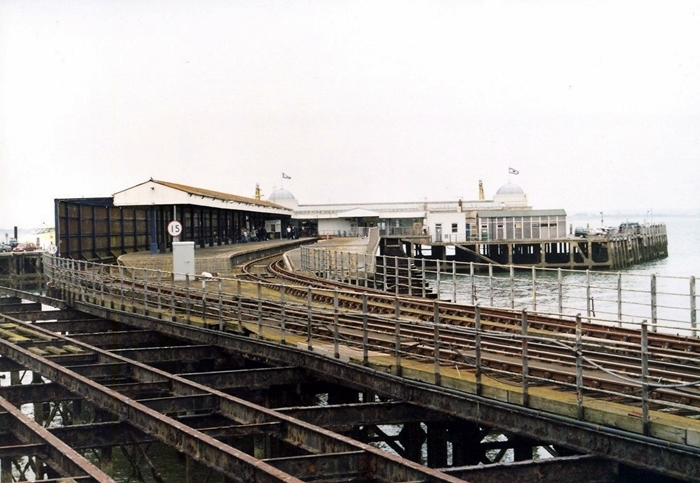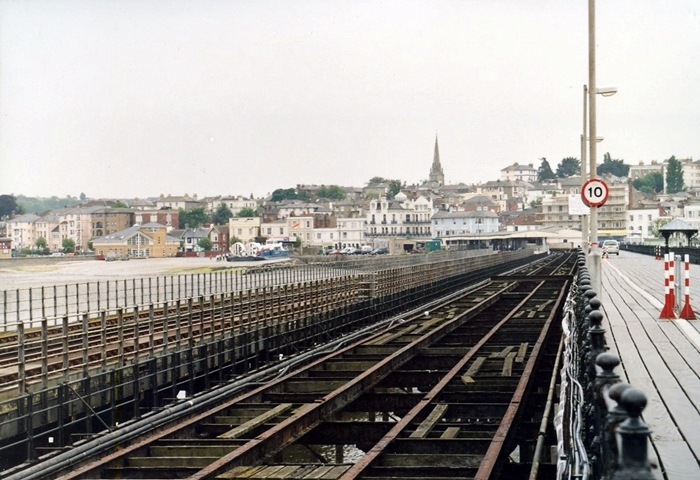
Ryde Pier Head
The Southern Railway assumed responsibility of the Isle of Wight’s railways in 1923, and improvements to stations, stock, and service frequency were soon made. That summer, second-hand mainland motive power arrived in the form of a pair of ‘’O2’’ Tank Engines, designed by William Adams. Modified at Eastleigh and still in LSWR colours, the locomotives were Nos. 206 and 211, which eventually became Nos. 19 ‘’Osborne’’ and 20 ‘’Shanklin’’ respectively. The two engines were lifted onto the railway at Ryde Pier Head, when the SR temporarily took loan of the Admiralty’s Portsmouth-based floating crane. In the same year, the company began a virtual rebuild of Pier Head station. The pier was extended along its western side and the windbreak here abolished, to permit the installation of a fourth track and platform face. A new, windowless windbreak was erected alongside the platform line, and was attached to the western canopy by a series of horizontally-laid iron bars. The canopies themselves were rebuilt, and whilst the triangular profile was maintained, the framework was new and valances were of the plain riveted steel type. 35-foot lengths of the original canopies were, however, retained between the new builds and the covered concourse. Riveted steel valances were a standard SR feature, and canopies of this type came into use at Kent Coast stations Herne Bay, Ramsgate, and Dumpton Park in the same decade. The timber buildings at the end of the station were abolished and replaced by a grand 135-foot-long façade. This was a single-storey affair, flanked on either side by towers, and had an exterior covered in stucco. An 80-foot-long hipped roof canopy, supported upon four struts, extended from the main building’s northern elevation, and a covered concourse was maintained by a pair of W-shaped canopies, which resided at right angles to those of the platform surfaces. The steam cranes at the end of the pier were replaced by electric variants, and wheeled cages – hauled by a petrol tractor – conveyed luggage between boat and train. Conversely, the adjacent tramway, which also passed into SR ownership, switched from electric to petrol traction. Platforms were numbered 1 to 4 from east to west, and just beyond the southern ends of Nos. 1 and 2 was erected a water tower. During the rebuilding the original signal box was retained, and a scissors crossing, which allowed all platform lines to be accessed from either ‘’up’’ or ‘’down’’ tracks on the final station approach, was installed.
The SR maintained a half-hourly service between the Pier Head and Ventnor in the
summer season. As mentioned elsewhere on the website, the route was entirely
seasonal in nature, with considerable traffic in the summer peak, but very
little in the winter months. Averaged out across the year, however, receipts
were indeed respectable, at least by branch line standards. Naturally, decline
of the island’s interesting network of lines became the order of the day under
British Railways ownership. Closure loomed over all lines, but in July 1965,
after much protest, the Minster of Transport confirmed that the Ryde Pier Head
to Shanklin section of the Isle of Wight’s railway system could remain open.
However, the Shanklin to Ventnor, and Smallbrook Junction to Newport and Cowes
routes would still be taken out of use. In November 1965, electrification of the
remaining Pier Head to Shanklin line was authorised, by which time arrangements
had been made with London Transport for the purchase of 43 Tube vehicles,
converted to third rail operation. Loading gauge issues, particularly concerning
the twin-bore tunnel in-between Ryde Esplanade and St Johns Road stations,
precluded the use of standard mainline stock. Wroxall and Ventnor stations were
no longer part of the line as of 18th April 1966. On 17th September of the same
year, Ryde Pier Head also saw its last steam services; the station was closed
from the following day to permit major structural alterations to be made for the
electrification scheme.
Reconstruction at the Pier Head involved the elimination of the existing
platform line Nos. 1 and 2, abolition of the water tower, but retention of the
signal box and semaphores. The track bed of platform line No. 1 was wholly
dismantled using a rail-based steam crane, but the supporting piers remained
extant in the water. The elimination of line No. 2 allowed the widening of the
eastern island platform across this track bed; thus, the former No. 3 line was
served on both sides by a platform face. The result of the works produced a
relegated layout of two tracks served by three platforms faces. A double-sided
platform allowed passengers to embark on a train from one side, and alight from
the same train on the opposite side, producing a continuous movement of people.
Pier Head station re-opened with the commencement of the new electric services
on 20th March 1967, and an hourly service in each direction between Pier Head
and Shanklin was run in the winter months. An improved electric service along
the pier to Esplanade negated the usefulness of the adjacent tramway, and this
subsequently closed in 1969, the final services running on 26th January of that
year. The rails of the latter were dismantled in March 1970, the large pavilion
at its head demolished, but the pier framework left standing.
Re-signalling in 1974 allowed the closure of Ryde Pier Head signal box on 5th
May of that year, and the removal of the station’s remaining semaphores. This
involved the elimination of the scissors crossing between the running lines, the
latter of which were signalled for reversible running between Pier Head and St
Johns Road. Further degrading took place in the following decade: in 1987, the
eastern of the two platform canopies was demolished, making the station even
more exposed. The western canopy, plus windbreak, was retained, and the station
assumed the form it still takes today.
13th June 2006

Pier Head station head-on, and much interest in view. On the far left is the timber windbreak, beside which is
the station's only regularly operational platform line. The double-sided platform of 1967 is virtually disused and
has lacked a canopy since 1987. The section of the Pier Head which hosts that station building is supported upon
a framework of reinforced concrete, erected during the SR rebuilding. David Glasspool
13th June 2006

A southward view shows all three piers. From left to right: railway; tramway; and walkway. The origins of the
latter are the oldest, dating back to 1814, although rebuilding from timber to cast-iron commenced in 1884.
David Glasspool
Return to the Kent Rail Homepage or alternatively, check for Updates.
Website & Copyright information - Links - Contact the Webmaster
All content is copyright © David Glasspool unless otherwise stated